「雲・地図アート」をロスのアートスクールで教える: Teaching My "Cloud/Map Art" to Children at LA Art School [Report]
私の「雲・地図アート」をロスのアートスクールで子供たちに教える
去る10月25日木曜に、ロスのロヨラヴィレッジ・アートマグネットスクールのアート担当ニッキ―バレル先生と1か月ほどの相談と準備を経て、彼女のクラス(午前中1クラスと午後2クラス)で小学3年生に「雲アート」と「地図アート」を教えてみました。これは雲の形や地図の形をもとに思いついた絵を描かせるものです。
クラスの冒頭で私の描いた例を見せて子供たちに何をしたらいいかを示した後、雲や地図が映った写真のコピーを配布しました。以下の最初の2つの写真(雲は「猫」の絵で地図は「犬」の絵)が私が子供たちに見せた例で、これだけで子供たちは何をすべきかよく理解したようです。
クラスではバレル先生のサポートもあってとてもスムーズに進みました(写真3枚目は例を示している私、4-5枚目は生徒たちの様子)。実際子供たちは私に予想以上の創造力を発揮して例えば雲アートでは、私が以前つくばの雲をもとに描いた「妖怪大戦争」を見せなかったにもかかわらず同じような発想で実にカラフルな面白い絵を描き(6枚目の写真)、さらに地図アートでは私が日本地図の例を見せたのに対してアメリカ合衆国の地図を上下さかさまにして見事な絵を描いた小学3年生の独創性に感服(7枚目の写真)! まさにピカソが言ったように「子供は誰もがアーティスト」。
今回の経験から学んだものは大きく、特に子供たちのアートの自由な創造力をいかに伸ばすか、またアートを地理や歴史など他の科目の学習にいかに活かすかなどについて大きなヒントが得られました。今後もこのような経験を重ねてさらに子供たちの興味や創造性を刺激する方法を考えていきたいと思います。
Teaching My "Cloud/Map Art" to Children at LA Art School
On Thursday, October 25, after a month of preparation and consultation with art teacher Ms. Nickie Burrell of Loyola Village Arts Magnet School in LA, I went to her classes, one class in the morning and two classes in the afternoon, to teach third graders what I call “cloud-map” art, that is, drawings based on the shapes of clouds or maps in the pictures handed out to them.
In each class I showed my own drawings as examples so that the children can get an idea about what to do in class. I gave one example for each of the cloud and map pictures (see the first two photos attached)
I think my teaching went smoothly, thanks to the help of Ms. Burrell, and the children more or less followed my instructions to work on the pictures that I handed out (see the 3rd - 5th photos attached).
Actually, I was really impressed by creative ideas exhibited by some of the third graders, who are still free of the “commonsense,” in their artworks such as “monster war” cloud art (see the 6th photo) and “upside down USA” map art (the 7th photo), by getting my idea, Indeed, “every child is an artist,” as Pablo Picasso said!
I feel like I learned a lot about my teaching experience in these classes, especially, how to encourage children’s spontaneity and creativity in art, and possibly in learning other subject matters like geography, history, etc.
I hope I will be able to come back to try more of my ideas along this line to stimulate children’s interest and creativity further in the future.
私の「雲・地図アート 」の例: Examples of My "Cloud/Map Art" Shown in Class
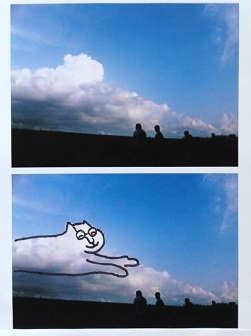
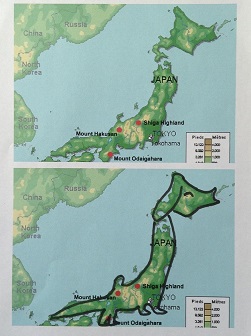
私の授業とクラスの状況: My Teaching and Class Scenes
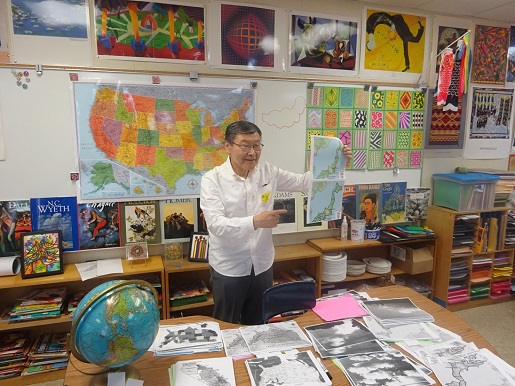
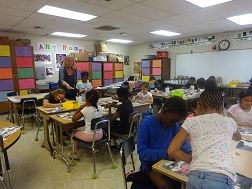

生徒たちの創造的な雲・地図アート作品: Children's Creative Cloud/Map Artworks
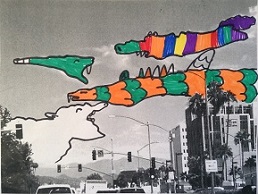
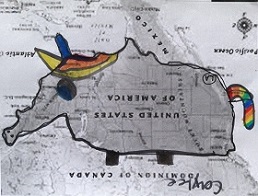
-------------------------------------------------------------------------------------------
去る10月25日木曜に、ロスのロヨラヴィレッジ・アートマグネットスクールのアート担当ニッキ―バレル先生と1か月ほどの相談と準備を経て、彼女のクラス(午前中1クラスと午後2クラス)で小学3年生に「雲アート」と「地図アート」を教えてみました。これは雲の形や地図の形をもとに思いついた絵を描かせるものです。
クラスの冒頭で私の描いた例を見せて子供たちに何をしたらいいかを示した後、雲や地図が映った写真のコピーを配布しました。以下の最初の2つの写真(雲は「猫」の絵で地図は「犬」の絵)が私が子供たちに見せた例で、これだけで子供たちは何をすべきかよく理解したようです。
クラスではバレル先生のサポートもあってとてもスムーズに進みました(写真3枚目は例を示している私、4-5枚目は生徒たちの様子)。実際子供たちは私に予想以上の創造力を発揮して例えば雲アートでは、私が以前つくばの雲をもとに描いた「妖怪大戦争」を見せなかったにもかかわらず同じような発想で実にカラフルな面白い絵を描き(6枚目の写真)、さらに地図アートでは私が日本地図の例を見せたのに対してアメリカ合衆国の地図を上下さかさまにして見事な絵を描いた小学3年生の独創性に感服(7枚目の写真)! まさにピカソが言ったように「子供は誰もがアーティスト」。
今回の経験から学んだものは大きく、特に子供たちのアートの自由な創造力をいかに伸ばすか、またアートを地理や歴史など他の科目の学習にいかに活かすかなどについて大きなヒントが得られました。今後もこのような経験を重ねてさらに子供たちの興味や創造性を刺激する方法を考えていきたいと思います。
Teaching My "Cloud/Map Art" to Children at LA Art School
On Thursday, October 25, after a month of preparation and consultation with art teacher Ms. Nickie Burrell of Loyola Village Arts Magnet School in LA, I went to her classes, one class in the morning and two classes in the afternoon, to teach third graders what I call “cloud-map” art, that is, drawings based on the shapes of clouds or maps in the pictures handed out to them.
In each class I showed my own drawings as examples so that the children can get an idea about what to do in class. I gave one example for each of the cloud and map pictures (see the first two photos attached)
I think my teaching went smoothly, thanks to the help of Ms. Burrell, and the children more or less followed my instructions to work on the pictures that I handed out (see the 3rd - 5th photos attached).
Actually, I was really impressed by creative ideas exhibited by some of the third graders, who are still free of the “commonsense,” in their artworks such as “monster war” cloud art (see the 6th photo) and “upside down USA” map art (the 7th photo), by getting my idea, Indeed, “every child is an artist,” as Pablo Picasso said!
I feel like I learned a lot about my teaching experience in these classes, especially, how to encourage children’s spontaneity and creativity in art, and possibly in learning other subject matters like geography, history, etc.
I hope I will be able to come back to try more of my ideas along this line to stimulate children’s interest and creativity further in the future.
私の「雲・地図アート 」の例: Examples of My "Cloud/Map Art" Shown in Class


私の授業とクラスの状況: My Teaching and Class Scenes



生徒たちの創造的な雲・地図アート作品: Children's Creative Cloud/Map Artworks


-------------------------------------------------------------------------------------------
2018-11-07 12:23
コメント(0)
龍谷大学バークレーセンターでのディベートの評価 [Report]
龍谷大学バークレーセンターでのディベートの評価
Date: 2017年12月11日~12日
Place: 龍谷大学バークレーセンター@カリフォルニア・バークレー
評価結果のまとめ: Summary of Student Evaluation (宮尾: T. Miyao)
( * ) はチェックした学生の数: ( * ) shows # of students
--------------------------------------------------------------------------------------------------
Debate 1: ベーシック・インカム: Basic income
サイドA: For basic income vs. サイドB: Against basic Income
1) どちらのサイドが説得的だったか: Which side was more persuasive?
( 6 ) サイド A, ( 8 ) まったく同じ, ( 9 ) サイドB
2) 「ディベート前」の自分の意見: My opinion BEFORE the debate
( 3 ) Aと同意見, (10) Aに近い, ( 2 ) 両方同じ程度, ( 6 ) Bに近い, ( 2 ) Bと同意見
3) 「ディベート後」の自分の意見: My opinion AFTER the debate
( 3 ) Aと同意見, ( 5 ) Aに近い, ( 1 ) 両方同じ程度, (10) Bに近い, ( 4 ) Bと同意見
MIYAO: Side B debaters did such a good job that quite a few side-A students were persuaded to switch sides from A to B, making B the majority opinion now
------------------------------------------------------------------------------------------------
Debate 2: 子供の習い事: Lessons in childhood
サイドA: For lessons in childhood vs. サイドB: Against lessons in childhood
1) どちらのサイドが説得的だったか: Which side was more persuasive?
( 11 ) サイド A, ( 9 ) まったく同じ, ( 4 ) サイドB
2) 「ディベート前」の自分の意見: My opinion BEFORE the debate
(10) Aと同意見, ( 6 ) Aに近い, ( 1 ) 両方同じ程度, ( 4 ) Bに近い, ( 3 ) Bと同意見
3) 「ディベート後」の自分の意見: My opinion AFTER the debate
( 8 ) Aと同意見, ( 7 ) Aに近い, ( 5 ) 両方同じ程度, ( 3 ) Bに近い, ( 1 ) Bと同意見
MIYAO: Clearly side A won, as it was a very popular opinion from the beginning. Good exercise to think of a better argument for side B (ask your US friends)
----------------------------------------------------------------------------------------------
Debate 3: 都市の農地/農業: Urban farming
サイドA: For urban farming vs. サイドB: Against urban farming
1) どちらのサイドがより説得的だったか: Which side was more persuasive?
( 6 ) サイド A, ( 8 ) まったく同じ, ( 8 ) サイドB
2) 「ディベート前」の自分の意見: My opinion BEFORE the debate
( 6 ) Aと同意見, ( 4 ) Aに近い, ( 7 ) 両方同じ程度, ( 4 ) Bに近い, ( 3 ) Bと同意見
3) 「ディベート後」の自分の意見: My opinion AFTER the debate
( 3 ) Aと同意見, ( 6 ) Aに近い, ( 5 ) 両方同じ程度, ( 4 ) Bに近い, ( 6 ) Bと同意見
MIYAO: Very close. A strong argument by a side B debater made the difference
-------------------------------------------------------------------------------------------------
Date: 2017年12月11日~12日
Place: 龍谷大学バークレーセンター@カリフォルニア・バークレー
評価結果のまとめ: Summary of Student Evaluation (宮尾: T. Miyao)
( * ) はチェックした学生の数: ( * ) shows # of students
--------------------------------------------------------------------------------------------------
Debate 1: ベーシック・インカム: Basic income
サイドA: For basic income vs. サイドB: Against basic Income
1) どちらのサイドが説得的だったか: Which side was more persuasive?
( 6 ) サイド A, ( 8 ) まったく同じ, ( 9 ) サイドB
2) 「ディベート前」の自分の意見: My opinion BEFORE the debate
( 3 ) Aと同意見, (10) Aに近い, ( 2 ) 両方同じ程度, ( 6 ) Bに近い, ( 2 ) Bと同意見
3) 「ディベート後」の自分の意見: My opinion AFTER the debate
( 3 ) Aと同意見, ( 5 ) Aに近い, ( 1 ) 両方同じ程度, (10) Bに近い, ( 4 ) Bと同意見
MIYAO: Side B debaters did such a good job that quite a few side-A students were persuaded to switch sides from A to B, making B the majority opinion now
------------------------------------------------------------------------------------------------
Debate 2: 子供の習い事: Lessons in childhood
サイドA: For lessons in childhood vs. サイドB: Against lessons in childhood
1) どちらのサイドが説得的だったか: Which side was more persuasive?
( 11 ) サイド A, ( 9 ) まったく同じ, ( 4 ) サイドB
2) 「ディベート前」の自分の意見: My opinion BEFORE the debate
(10) Aと同意見, ( 6 ) Aに近い, ( 1 ) 両方同じ程度, ( 4 ) Bに近い, ( 3 ) Bと同意見
3) 「ディベート後」の自分の意見: My opinion AFTER the debate
( 8 ) Aと同意見, ( 7 ) Aに近い, ( 5 ) 両方同じ程度, ( 3 ) Bに近い, ( 1 ) Bと同意見
MIYAO: Clearly side A won, as it was a very popular opinion from the beginning. Good exercise to think of a better argument for side B (ask your US friends)
----------------------------------------------------------------------------------------------
Debate 3: 都市の農地/農業: Urban farming
サイドA: For urban farming vs. サイドB: Against urban farming
1) どちらのサイドがより説得的だったか: Which side was more persuasive?
( 6 ) サイド A, ( 8 ) まったく同じ, ( 8 ) サイドB
2) 「ディベート前」の自分の意見: My opinion BEFORE the debate
( 6 ) Aと同意見, ( 4 ) Aに近い, ( 7 ) 両方同じ程度, ( 4 ) Bに近い, ( 3 ) Bと同意見
3) 「ディベート後」の自分の意見: My opinion AFTER the debate
( 3 ) Aと同意見, ( 6 ) Aに近い, ( 5 ) 両方同じ程度, ( 4 ) Bに近い, ( 6 ) Bと同意見
MIYAO: Very close. A strong argument by a side B debater made the difference
-------------------------------------------------------------------------------------------------
2018-02-06 09:59
コメント(0)
USC Student Debate on Population Issues: USCの学生による人口問題のディベート [Report]
USC Student Debate on Population Issues: USCの学生による人口問題のディベート
Place: Economics Department Classroom, USC, Los Angeles, California;
場所: ロサンゼルスの南カリフォルニア大学経済学部の教室
Class: Debate on Population Problem in Economic Development
クラス:経済発展における人口問題に関するディベート
Issue: Pros and cons on population control; focusing on China and India
イシュー:人口抑制策の是非;中国とインドのケース
Reference: Debate Manual: https://lnkd.in/g4Rks3Y
参考: "ディベートの手引き" https://lnkd.in/gD-E4zq
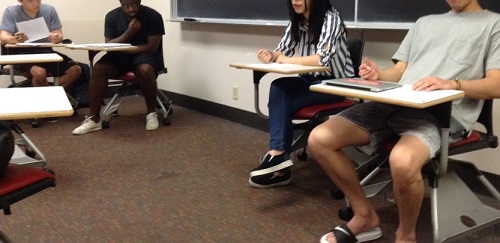
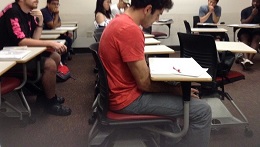
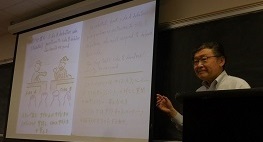
My Debate Class at USC to discuss population issues in economic development, mainly focusing on China & India; Students' opinions are evenly divided over the Chinese style of population control:
南カリフォルニア大学での「ディベート」のクラスで、特に中国とインドの経済発展における人口抑制策を議論: 中国型の人口抑制策への学生の賛否はほぼ半々.
-------------------------------------------------------------------------------
Place: Economics Department Classroom, USC, Los Angeles, California;
場所: ロサンゼルスの南カリフォルニア大学経済学部の教室
Class: Debate on Population Problem in Economic Development
クラス:経済発展における人口問題に関するディベート
Issue: Pros and cons on population control; focusing on China and India
イシュー:人口抑制策の是非;中国とインドのケース
Reference: Debate Manual: https://lnkd.in/g4Rks3Y
参考: "ディベートの手引き" https://lnkd.in/gD-E4zq



My Debate Class at USC to discuss population issues in economic development, mainly focusing on China & India; Students' opinions are evenly divided over the Chinese style of population control:
南カリフォルニア大学での「ディベート」のクラスで、特に中国とインドの経済発展における人口抑制策を議論: 中国型の人口抑制策への学生の賛否はほぼ半々.
-------------------------------------------------------------------------------
Debate Practice for Japanese Students: 日本人学生のディベート実践 [Report]
Debate Practice for Japanese Students in Silicon Valley, California
カリフォルニア・シリコンバレーでの日本人学生のディベート実践
Date: March 20-21, 2017; 日時:2017年3月20日~21日
Place: Pacific Motor Inn, San Jose, California: 場所:カリフォルニア・サンノゼ
Program: Kyushu Univ 5 week ELEP program: プログラム:九州大学5週間海外研修
A group of students from Kyushu University practiced a "formal debate" in the final week of their training program, organized by the Kyushu Univ. office in Silicon Valley, California.
Two important issues, AI (artificial intelligence) and nuclear energy, are taken up in the debate, first in Japanese on March 20, and then in English on March 21.
"Learning by doing" was the approach taken here, as this was a new experience for most students.
In this two-day practice, the students were offered opportunities to learn many things, from English to debate manner in addition to the issues themselves. In fact, on this program, especially in the debate practice, all the students made really impressive progress in the presentation and exchange of their opinions in Japanese and English as well.
For more details about the issues, see the reference at the bottom of this page.
九州大学カリフォルニア・シリコンバレーオフィスの研修に参加した学生たちによるディベートの実践。
2つの重要なイシューが取り上げられた:AI(人工知能)と原発問題。
初日(3月20日)は日本語で、翌日(3月21日)には英語で実施。
ほとんどの学生にとって公式ディベートは初めてだったこともあり「やりながら学ぶ」という方法をとり、イシューそのものに加えて英語からディベートのマナーにいたる多くことを学ぶ機会が提供された。
実際にこの研修プログラム、特にディベート実践によって、すべての学生が日本語および英語で自分の意見を表明し討論する能力と態度について目覚ましい進歩を遂げたといえる。
イシューの内容については、一番下の「参考」に掲載。
Program coordinator M. Matsuo introducing debate instructor T. Miyao
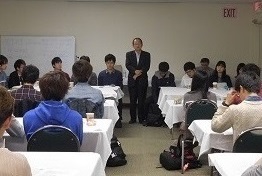
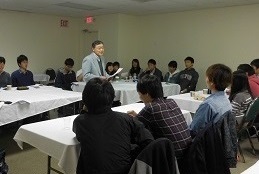
Students' debate on nuclear energy: "Pro" side (left) vs. "Con" side (right)
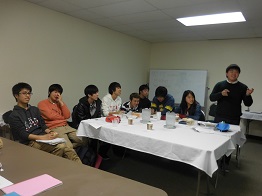
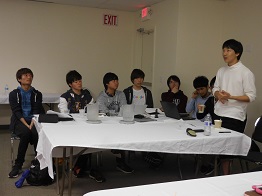
Final comments by Prof. Takamatsu and Group photo of all participants
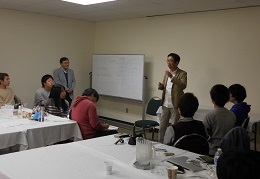
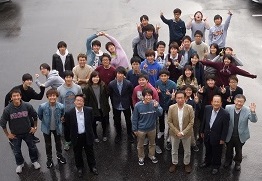
Reference; 参考:
Distribution material handed out to students prior to the debate
ディベート用に事前に学生たちに配布された参考資料
イシュー1:AI(人工知能)の将来は我々人間にとって福音か脅威か。あなたは推進派か慎重派か。
Issue 1: Is the future of AI likely a blessing or a threat for human beings? Are you bullish or cautious about the future of AI?
サイドA:推進派の立場:
AIの進歩はめざましく、我々の生活や仕事を根本から変えつつある。それはすでに情報、金融、商業などのサービスがますます便利になっていることに示されている。生産性も生活水準もAIの発展に伴って著しく改善するので、もっとも進歩したAIを持つ者が世界の将来を左右することになるであろう。
Side A: AI is advancing and helping our life and work significantly, as already shown in ever more convenient services in information, financial and retail business. Our productivity and living standard will be improved substantially with the development of AI, and those who possess the most advanced AI will prevail in the world in the future.
サイドB:慎重派の立場:
AIは誰の予想よりも速く進歩していて、すでに我々の仕事をかなり奪いつつあり、先端的な産業でさえも倒産、失業、低賃金などの深刻な問題を生み出している。そのような産業は実は最先端のAI技術を持つ数少ない巨大企業によって支配されている。その上、AIは間もなく「シンギュラりティー点」を超えて、人間がコントロールできなくなり、破壊的な結果をもたらす可能性がある。
Side B: AI is advancing itself faster than anyone has predicted, already replacing some workers and creating serious problems such as bankruptcies, unemployment and low wages even in advanced industries, which are now dominated by few giant companies with advanced AI technology. Furthermore, AI is bound to reach the "singularity point" beyond which AI could be uncontrollable and disastrous for human beings.
イシュー2:原発は、我々のエネルギー、技術、環境などのニーズの観点から必要か不必要か。あなたは原発に賛成ですか反対ですか。
Issue 2: Is nuclear power necessary or unnecessary to satisfy our needs for energy, technology, the environment, etc. Are you for or against nuclear energy?
サイドA:賛成派の立場:
資源に乏しい日本のような国では、原発がエネルギーと環境のニーズの両立というジレンマに応えるために、石炭、石油、天然ガスという化石燃料に対する唯一の現実的な代替エネルギーであり、クリーンな再生可能資源がまだエネルギー供給のごく僅かな部分にしか過ぎず、しかもコストが上昇している状況では特にそうである。原発の安全問題は、国際協力によって最新でより安全な原発技術の開発と投資によって対処する以外にない。
Side A: In a country like Japan without much natural resources, nuclear power is the only realistic alternative to fossil fuels such as oil, coal and natural gas, to reconcile the dilemma to satisfy both energy and environmental needs, as clean renewable resources are still a tiny fraction of energy supply with rising costs. The nuclear safety issue can only be addressed by international cooperation to develop and invest in newer and safer nuclear power technology.
サイドB:反対派の立場:
一国がエネルギーのニーズを満たすために、原発に依存するのは、あまりに深刻な問題があり危険なことである。コスト面でも、原子力発電所を稼働されるために必要な安全上の措置を考えても、もちろん原発事故が起こった時の膨大な費用を考慮しても高すぎる。さらに深刻なのは、核廃棄物の問題で、その処理は既存の技術では可能でないことである。原発なしにはエネルギー不足が短期的には避けられないが、クリーンな再生可能エネルギーを奨励して長期的なニーズを満たす以外にない。
Side B: Nuclear energy is too hazardous and dangerous for any country to rely on to satisfy its energy needs, and also it is too costly in view of all the safety measures required for nuclear power plant operations and, most of all, enormous costs imposed on society in case of accident. Equally serious is the nuclear waste issue, which cannot be treated with existing technologies. Although, without nuclear power, energy shortage may be unavoidable in the short run, clean renewable energy should be encouraged to meet the long-run energy needs.
------------------------------------------------------------------------------------------
カリフォルニア・シリコンバレーでの日本人学生のディベート実践
Date: March 20-21, 2017; 日時:2017年3月20日~21日
Place: Pacific Motor Inn, San Jose, California: 場所:カリフォルニア・サンノゼ
Program: Kyushu Univ 5 week ELEP program: プログラム:九州大学5週間海外研修
A group of students from Kyushu University practiced a "formal debate" in the final week of their training program, organized by the Kyushu Univ. office in Silicon Valley, California.
Two important issues, AI (artificial intelligence) and nuclear energy, are taken up in the debate, first in Japanese on March 20, and then in English on March 21.
"Learning by doing" was the approach taken here, as this was a new experience for most students.
In this two-day practice, the students were offered opportunities to learn many things, from English to debate manner in addition to the issues themselves. In fact, on this program, especially in the debate practice, all the students made really impressive progress in the presentation and exchange of their opinions in Japanese and English as well.
For more details about the issues, see the reference at the bottom of this page.
九州大学カリフォルニア・シリコンバレーオフィスの研修に参加した学生たちによるディベートの実践。
2つの重要なイシューが取り上げられた:AI(人工知能)と原発問題。
初日(3月20日)は日本語で、翌日(3月21日)には英語で実施。
ほとんどの学生にとって公式ディベートは初めてだったこともあり「やりながら学ぶ」という方法をとり、イシューそのものに加えて英語からディベートのマナーにいたる多くことを学ぶ機会が提供された。
実際にこの研修プログラム、特にディベート実践によって、すべての学生が日本語および英語で自分の意見を表明し討論する能力と態度について目覚ましい進歩を遂げたといえる。
イシューの内容については、一番下の「参考」に掲載。
Program coordinator M. Matsuo introducing debate instructor T. Miyao


Students' debate on nuclear energy: "Pro" side (left) vs. "Con" side (right)


Final comments by Prof. Takamatsu and Group photo of all participants


Reference; 参考:
Distribution material handed out to students prior to the debate
ディベート用に事前に学生たちに配布された参考資料
イシュー1:AI(人工知能)の将来は我々人間にとって福音か脅威か。あなたは推進派か慎重派か。
Issue 1: Is the future of AI likely a blessing or a threat for human beings? Are you bullish or cautious about the future of AI?
サイドA:推進派の立場:
AIの進歩はめざましく、我々の生活や仕事を根本から変えつつある。それはすでに情報、金融、商業などのサービスがますます便利になっていることに示されている。生産性も生活水準もAIの発展に伴って著しく改善するので、もっとも進歩したAIを持つ者が世界の将来を左右することになるであろう。
Side A: AI is advancing and helping our life and work significantly, as already shown in ever more convenient services in information, financial and retail business. Our productivity and living standard will be improved substantially with the development of AI, and those who possess the most advanced AI will prevail in the world in the future.
サイドB:慎重派の立場:
AIは誰の予想よりも速く進歩していて、すでに我々の仕事をかなり奪いつつあり、先端的な産業でさえも倒産、失業、低賃金などの深刻な問題を生み出している。そのような産業は実は最先端のAI技術を持つ数少ない巨大企業によって支配されている。その上、AIは間もなく「シンギュラりティー点」を超えて、人間がコントロールできなくなり、破壊的な結果をもたらす可能性がある。
Side B: AI is advancing itself faster than anyone has predicted, already replacing some workers and creating serious problems such as bankruptcies, unemployment and low wages even in advanced industries, which are now dominated by few giant companies with advanced AI technology. Furthermore, AI is bound to reach the "singularity point" beyond which AI could be uncontrollable and disastrous for human beings.
イシュー2:原発は、我々のエネルギー、技術、環境などのニーズの観点から必要か不必要か。あなたは原発に賛成ですか反対ですか。
Issue 2: Is nuclear power necessary or unnecessary to satisfy our needs for energy, technology, the environment, etc. Are you for or against nuclear energy?
サイドA:賛成派の立場:
資源に乏しい日本のような国では、原発がエネルギーと環境のニーズの両立というジレンマに応えるために、石炭、石油、天然ガスという化石燃料に対する唯一の現実的な代替エネルギーであり、クリーンな再生可能資源がまだエネルギー供給のごく僅かな部分にしか過ぎず、しかもコストが上昇している状況では特にそうである。原発の安全問題は、国際協力によって最新でより安全な原発技術の開発と投資によって対処する以外にない。
Side A: In a country like Japan without much natural resources, nuclear power is the only realistic alternative to fossil fuels such as oil, coal and natural gas, to reconcile the dilemma to satisfy both energy and environmental needs, as clean renewable resources are still a tiny fraction of energy supply with rising costs. The nuclear safety issue can only be addressed by international cooperation to develop and invest in newer and safer nuclear power technology.
サイドB:反対派の立場:
一国がエネルギーのニーズを満たすために、原発に依存するのは、あまりに深刻な問題があり危険なことである。コスト面でも、原子力発電所を稼働されるために必要な安全上の措置を考えても、もちろん原発事故が起こった時の膨大な費用を考慮しても高すぎる。さらに深刻なのは、核廃棄物の問題で、その処理は既存の技術では可能でないことである。原発なしにはエネルギー不足が短期的には避けられないが、クリーンな再生可能エネルギーを奨励して長期的なニーズを満たす以外にない。
Side B: Nuclear energy is too hazardous and dangerous for any country to rely on to satisfy its energy needs, and also it is too costly in view of all the safety measures required for nuclear power plant operations and, most of all, enormous costs imposed on society in case of accident. Equally serious is the nuclear waste issue, which cannot be treated with existing technologies. Although, without nuclear power, energy shortage may be unavoidable in the short run, clean renewable energy should be encouraged to meet the long-run energy needs.
------------------------------------------------------------------------------------------
Stanford Seminar on China in South Asia on Feb. 21, 2017 [Report]
Stanford Seminar: "China in South Asia's New Strategic Quadrangle"
Date/Time: February 21(T), 2017, 4:30-6:00pm
Venue: Philippines Conference Room, Encina Hall, Stanford
Sponsored by: Shorenstein Asia-Pacific Research Center
Speaker: Evan A. Feigenbaum, Vice Chairman, The Paulson Institute
Webpage: http://fsi.stanford.edu/events/china-south-asia%E2%80%99s-new-strategic-quadrangle
"South Asia is one of the least economically integrated regions of the world, but its future can no longer be divorced from broader trends in a dynamic, volatile, yet increasingly integrated Asia........ In this talk, Feigenbaum will explore China's changing role in South Asia but especially the complex interaction there among four big powers ("Asia's new strategic quadrangle) - India, China, the US, and Japan"
Dr. Evan Feigenbaum's talk and Q&A session
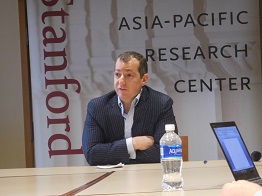
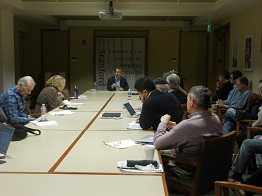
Comment: Despite its regionally focused title, the actual talk encompassed a whole range of strategic and economic changes in Asia and the Pacific rim. A strong message of the speaker emerged toward the end of his talk, especially during the Q&A session, that there seems to be no single, unified policy approach to various countries and regions on the part of China to dominate the whole region or the world for that matter, as is often feared by Western observers. This means that even if the US withdraws from some of the region-wide activities in Asia Pacific such as TPP, China could not automatically become the dominant strategic and economic power in the region; an "anti-alarmist" argument which reminds us of Dr. Harold Trinkunas' seminar on "China's role in Latin America" at Stanford on Feb. 1, 2017. See the following report:
Harold Trinkunas (Center for Int'l Security & Cooperation, Stanford) "A 'Comprehensive and Cooperative Partnership'?: Assessing China's Role in Latin America"
http://miyao-blog.blog.so-net.ne.jp/2017-02-02
(Takahiro Miyao)
-----------------------------------------------------------------------------------
Date/Time: February 21(T), 2017, 4:30-6:00pm
Venue: Philippines Conference Room, Encina Hall, Stanford
Sponsored by: Shorenstein Asia-Pacific Research Center
Speaker: Evan A. Feigenbaum, Vice Chairman, The Paulson Institute
Webpage: http://fsi.stanford.edu/events/china-south-asia%E2%80%99s-new-strategic-quadrangle
"South Asia is one of the least economically integrated regions of the world, but its future can no longer be divorced from broader trends in a dynamic, volatile, yet increasingly integrated Asia........ In this talk, Feigenbaum will explore China's changing role in South Asia but especially the complex interaction there among four big powers ("Asia's new strategic quadrangle) - India, China, the US, and Japan"
Dr. Evan Feigenbaum's talk and Q&A session


Comment: Despite its regionally focused title, the actual talk encompassed a whole range of strategic and economic changes in Asia and the Pacific rim. A strong message of the speaker emerged toward the end of his talk, especially during the Q&A session, that there seems to be no single, unified policy approach to various countries and regions on the part of China to dominate the whole region or the world for that matter, as is often feared by Western observers. This means that even if the US withdraws from some of the region-wide activities in Asia Pacific such as TPP, China could not automatically become the dominant strategic and economic power in the region; an "anti-alarmist" argument which reminds us of Dr. Harold Trinkunas' seminar on "China's role in Latin America" at Stanford on Feb. 1, 2017. See the following report:
Harold Trinkunas (Center for Int'l Security & Cooperation, Stanford) "A 'Comprehensive and Cooperative Partnership'?: Assessing China's Role in Latin America"
http://miyao-blog.blog.so-net.ne.jp/2017-02-02
(Takahiro Miyao)
-----------------------------------------------------------------------------------
"How to Debate" for Students from Kyushu U.: 九大生のための「ディベートの仕方」 [Report]
Lecture on "How to Debate" for Students from Kyushu U.@SJSU Campus
九大生グループのための「ディベートのやり方」の講義@サンノゼ州立大学キャンパス
Date/Time: 2/21(T), 2017, 1:30-2:15pm; 日時 2月21日(火)13:30~14:15
Place: SJSU Engineering Building: 場所 サンノゼ州立大学・工学部ビル
A brief instruction about "how to debate" was given to a group of students from Kyushu University, participating in their five-week training program in Silicon Valley. Their actual debate exercise will be held in late March.
シリコンバレーで5週間の研修を受けている九州大学の学生たちに「ディベートのやり方」についての講義があった。ディベートの実習は3月後半に実施される予定。
SJSU Campus Scene; サンノゼ州立大学のキャンパス風景
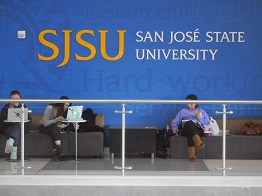
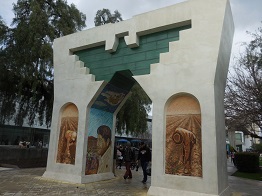
Engineering Building & Student Union; 工学部ビルと学生食堂周辺の様子
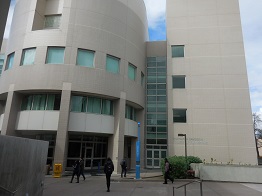
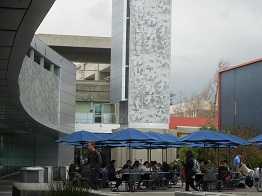
Dr Matsuo's introduction & Dr Miyao's lecture; 松尾氏による紹介と宮尾氏の講義
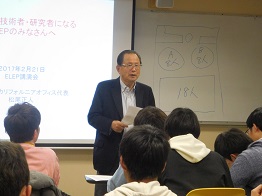
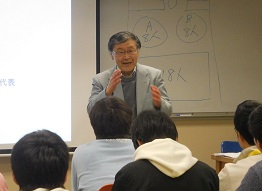
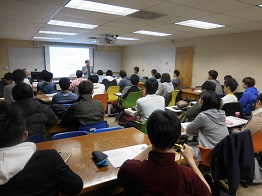

References; 参考
1. "Debate Manual" (Illustrations by T. Miyao): https://youtu.be/xfLQAUzikkQ
2. 「ディベートの手引き」(絵・宮尾尊弘): https://youtu.be/4V9tlXwtypo
----------------------------------------------------------------------------------------
九大生グループのための「ディベートのやり方」の講義@サンノゼ州立大学キャンパス
Date/Time: 2/21(T), 2017, 1:30-2:15pm; 日時 2月21日(火)13:30~14:15
Place: SJSU Engineering Building: 場所 サンノゼ州立大学・工学部ビル
A brief instruction about "how to debate" was given to a group of students from Kyushu University, participating in their five-week training program in Silicon Valley. Their actual debate exercise will be held in late March.
シリコンバレーで5週間の研修を受けている九州大学の学生たちに「ディベートのやり方」についての講義があった。ディベートの実習は3月後半に実施される予定。
SJSU Campus Scene; サンノゼ州立大学のキャンパス風景


Engineering Building & Student Union; 工学部ビルと学生食堂周辺の様子


Dr Matsuo's introduction & Dr Miyao's lecture; 松尾氏による紹介と宮尾氏の講義




References; 参考
1. "Debate Manual" (Illustrations by T. Miyao): https://youtu.be/xfLQAUzikkQ
2. 「ディベートの手引き」(絵・宮尾尊弘): https://youtu.be/4V9tlXwtypo
----------------------------------------------------------------------------------------
Revisit to SF Bay Area (2017/1/31-2/2): SFベイエリア再訪 [Report]
Visit to SF Bay Area (1/31-2/2, 2017): SFベイエリア訪問(2017/1/31-2/2)
Main purposes: To give a "Certificate of Appreciation" to outgoing JUNBA Chair & Osaka Univ. office head Mr. Kabasawa, and consult with Kyushu Univ. office head Mr. Matsuo about my upcoming debate class for his student group, as well as to attend three Stanford seminars on Japan and China.
訪問の主目的: 間もなくJUNBA(ベイエリア大学ネットワーク)代表と阪大北米センター長の職を退く樺澤氏に「感謝状」を贈呈し、また九大カリフォルニアオフィス代表の松尾氏とディベート実施について相談するとともに、日本と中国に関する3つのスタンフォード大セミナーに参加すること。
Day 1: January 31(T) ; 1日目:1月31日(火)
Revisiting Osaka Univ. Office in SF: 大阪大学北米センター・樺澤氏再訪
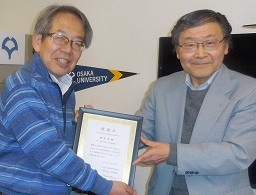
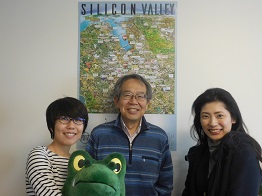
Revisiting JSPA Office in Berkeley: JSPSオフィス・田宮氏再訪
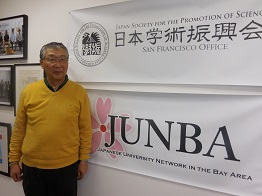
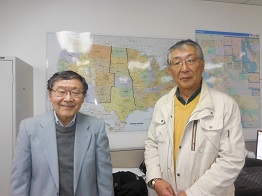
Seminar on Japanese Women in Business: スタンフォードセミナー「日本の女性とビジネス」
@Stanford Univ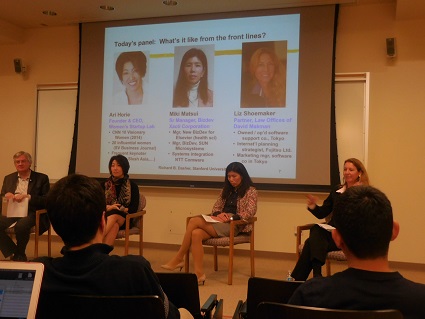
-------------------------------------------------------------------------------
Day 2: February 1(W) ; 2日目:2月1日(水)
Attending two seminars on Japan & China; 日本と中国についてのセミナー参加
Venue: Encina Hall, Stanford University; 場所:スタンフォート大学エンシナホール
Seminar report: セミナー報告: http://miyao-blog.blog.so-net.ne.jp/2017-02-02
Seminar 1) 12:00-1:30pm; セミナー1:12:00-13:30
"Corporate Governance Reform in Japan"; 「日本の企業統治改革」
Speaker: Hideaki Miyajima (Waseda Univ); 宮島英昭早稲田大学教授
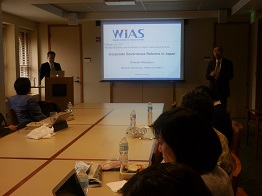
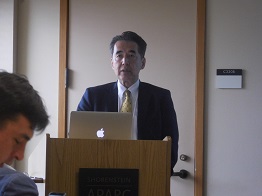
Seminar 2) 4:30-6:00pm; セミナー2: 16:30-18:00
"A 'Comprehensive and Cooperative Partnership'?: China's Role in Latin America";
「包括的で協力的なパートナーシップか?:中南米での中国の役割」
Speaker: Harold Trinkunas (Center for Int'l Security & Cooperation, Stanford)
Moderator/Commentator: Thomas Fingar (FSI, Stanford Univ.)
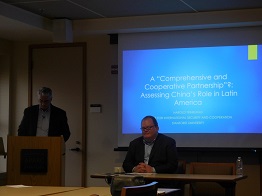
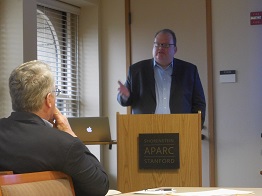
--------------------------------------------------------------------------------
Day 3: February 2(Th) ; 3日目:2月2日(木)
Revisiting Kyushu Univ. Office to meet Mr. Matsuo & visiting Univ. members
九州大学オフィスで松尾代表および訪問中の山田淳九大教授グループと会合
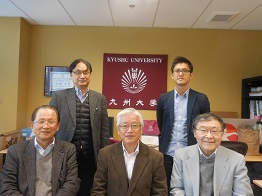
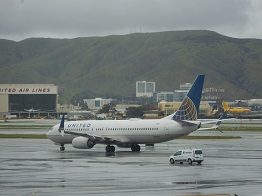
Leaving SFO for LAX in the afternoon: 午後にSF空港発でLAへ
---------------------------------------------------------------------------------
Main purposes: To give a "Certificate of Appreciation" to outgoing JUNBA Chair & Osaka Univ. office head Mr. Kabasawa, and consult with Kyushu Univ. office head Mr. Matsuo about my upcoming debate class for his student group, as well as to attend three Stanford seminars on Japan and China.
訪問の主目的: 間もなくJUNBA(ベイエリア大学ネットワーク)代表と阪大北米センター長の職を退く樺澤氏に「感謝状」を贈呈し、また九大カリフォルニアオフィス代表の松尾氏とディベート実施について相談するとともに、日本と中国に関する3つのスタンフォード大セミナーに参加すること。
Day 1: January 31(T) ; 1日目:1月31日(火)
Revisiting Osaka Univ. Office in SF: 大阪大学北米センター・樺澤氏再訪


Revisiting JSPA Office in Berkeley: JSPSオフィス・田宮氏再訪


Seminar on Japanese Women in Business: スタンフォードセミナー「日本の女性とビジネス」
@Stanford Univ

-------------------------------------------------------------------------------
Day 2: February 1(W) ; 2日目:2月1日(水)
Attending two seminars on Japan & China; 日本と中国についてのセミナー参加
Venue: Encina Hall, Stanford University; 場所:スタンフォート大学エンシナホール
Seminar report: セミナー報告: http://miyao-blog.blog.so-net.ne.jp/2017-02-02
Seminar 1) 12:00-1:30pm; セミナー1:12:00-13:30
"Corporate Governance Reform in Japan"; 「日本の企業統治改革」
Speaker: Hideaki Miyajima (Waseda Univ); 宮島英昭早稲田大学教授


Seminar 2) 4:30-6:00pm; セミナー2: 16:30-18:00
"A 'Comprehensive and Cooperative Partnership'?: China's Role in Latin America";
「包括的で協力的なパートナーシップか?:中南米での中国の役割」
Speaker: Harold Trinkunas (Center for Int'l Security & Cooperation, Stanford)
Moderator/Commentator: Thomas Fingar (FSI, Stanford Univ.)


--------------------------------------------------------------------------------
Day 3: February 2(Th) ; 3日目:2月2日(木)
Revisiting Kyushu Univ. Office to meet Mr. Matsuo & visiting Univ. members
九州大学オフィスで松尾代表および訪問中の山田淳九大教授グループと会合


Leaving SFO for LAX in the afternoon: 午後にSF空港発でLAへ
---------------------------------------------------------------------------------
Stanford Seminars on Japan & China on Feb. 1, 2017 [Report]
Stanford Seminars on Japan and China
Date: February 1(W), 2017
Venue: Philippines Conference Room, Encina Hall, Stanford Univeristy
1) 12:00-1:30pm
"Corporate Governance Reform in Japan": Japan Colloquium Series
Speaker: Hideaki Miyajima (Waseda University)
Moderator/Commentator: Takeo Hoshi (FSI, Stanford University)
(From seminar abstract):
Since Abenomics launched corporate governance reforms as the third arrow of its policies mix, a series of reform measures were introduced such as Stewardship Code, Corporate Governance Code, organizing JPX 400 by Tokyo Stock Exchange. In this presentation, first, recent changes of governance arrangement in Japanese firms are summarized, and some agenda for further reforms is suggested.


Prof. Hideaki Miyajima: http://www.rieti.go.jp/users/miyajima-hideaki/
(English) http://www.rieti.go.jp/users/miyajima-hideaki/index_en.html
(Miyao's report):
Very informative presentation about recent developments in corporate governance reform in Japan. A more detailed account of current issues on this subject matter should be found in Prof. Miyajima's forthcoming book "Corporate Governance and Growth Strategy" (「企業統治と成長戦略」to be published soon, as he pointed out. From the viewpoint of economic theorists like myself, it was quite interesting to hear from him that the current "hybrid" arrangement of Japanese corporate organization, combining the traditional "Japan model" and the "US model" of corporate governance, appears to be stable, contrary to theoretical intuition. Prof. Miyajima did not provide an explanation about this stability property, other than saying that many of the Japanese representative firms seem to have been in some hybrid situation for more than a decade without showing any sign to go to either the purely Japanese or US model. Hopefully in his forthcoming book, at least some more detailed, especially theoretical, account will be presented to persuade both theorists and empiricists on this matter.
2) 4:30-6:00pm
"A 'Comprehensive and Cooperative Partnership'?: Assessing China's Role in Latin America": Asia-Pacific Research Center Event
Speaker: Harold Trinkunas (Center for Int'l Security & Cooperation, Stanford)
Moderator/Commentator: Thomas Fingar (FSI, Stanford Univ.)
(From seminar abstract):
Latin American trade with China has grown exponentially since 2000. Major loans and investments also add to China’s growing role in the region’s economy. China has become an important alternative for capital, trade and technology for Latin America, but without the policy conditionality that regional governments have traditionally experienced in relations with developed countries. As part of a project on China-Latin American relations at the Brookings Institution, Harold Trinkunas assesses how China’s growing economic relations actually influence politics and policies across the region.


Harold Trinkunas: http://cisac.fsi.stanford.edu/people/harold-trinkunas
Thomas Fingar: http://aparc.fsi.stanford.edu/people/thomas_fingar
(Miyao's report):
Very comprehensive and balanced analysis of China's political, economic, and strategic influence in the Latin American region. However, the bottom line conclusion of the speaker's (and the commentator's) argument was something like "China's influence on Latin America in the foreseeable future would be more limited than generally perceived, regardless of what happens to the both Chinese and American sides (even under the Trump administration), in view of the long-term relationship between Latin America and the advanced Western countries, especially the US, still dominating Latin American economies," a view which is not so easily subscribed to by Asian observers like myself, who are more concerned about China's hegemony in Asia and the Pacific-rim region including some Latin American countries, especially in the aftermath of the failure of TPP. as I questioned to these two specialists, who answered my question by saying that the US could effectively deal with Pacific-rim nations even in a bilateral fashion, as US President Trump suggested. We all hope so.
-------------------------------------------------------------------------------------------
Date: February 1(W), 2017
Venue: Philippines Conference Room, Encina Hall, Stanford Univeristy
1) 12:00-1:30pm
"Corporate Governance Reform in Japan": Japan Colloquium Series
Speaker: Hideaki Miyajima (Waseda University)
Moderator/Commentator: Takeo Hoshi (FSI, Stanford University)
(From seminar abstract):
Since Abenomics launched corporate governance reforms as the third arrow of its policies mix, a series of reform measures were introduced such as Stewardship Code, Corporate Governance Code, organizing JPX 400 by Tokyo Stock Exchange. In this presentation, first, recent changes of governance arrangement in Japanese firms are summarized, and some agenda for further reforms is suggested.


Prof. Hideaki Miyajima: http://www.rieti.go.jp/users/miyajima-hideaki/
(English) http://www.rieti.go.jp/users/miyajima-hideaki/index_en.html
(Miyao's report):
Very informative presentation about recent developments in corporate governance reform in Japan. A more detailed account of current issues on this subject matter should be found in Prof. Miyajima's forthcoming book "Corporate Governance and Growth Strategy" (「企業統治と成長戦略」to be published soon, as he pointed out. From the viewpoint of economic theorists like myself, it was quite interesting to hear from him that the current "hybrid" arrangement of Japanese corporate organization, combining the traditional "Japan model" and the "US model" of corporate governance, appears to be stable, contrary to theoretical intuition. Prof. Miyajima did not provide an explanation about this stability property, other than saying that many of the Japanese representative firms seem to have been in some hybrid situation for more than a decade without showing any sign to go to either the purely Japanese or US model. Hopefully in his forthcoming book, at least some more detailed, especially theoretical, account will be presented to persuade both theorists and empiricists on this matter.
2) 4:30-6:00pm
"A 'Comprehensive and Cooperative Partnership'?: Assessing China's Role in Latin America": Asia-Pacific Research Center Event
Speaker: Harold Trinkunas (Center for Int'l Security & Cooperation, Stanford)
Moderator/Commentator: Thomas Fingar (FSI, Stanford Univ.)
(From seminar abstract):
Latin American trade with China has grown exponentially since 2000. Major loans and investments also add to China’s growing role in the region’s economy. China has become an important alternative for capital, trade and technology for Latin America, but without the policy conditionality that regional governments have traditionally experienced in relations with developed countries. As part of a project on China-Latin American relations at the Brookings Institution, Harold Trinkunas assesses how China’s growing economic relations actually influence politics and policies across the region.


Harold Trinkunas: http://cisac.fsi.stanford.edu/people/harold-trinkunas
Thomas Fingar: http://aparc.fsi.stanford.edu/people/thomas_fingar
(Miyao's report):
Very comprehensive and balanced analysis of China's political, economic, and strategic influence in the Latin American region. However, the bottom line conclusion of the speaker's (and the commentator's) argument was something like "China's influence on Latin America in the foreseeable future would be more limited than generally perceived, regardless of what happens to the both Chinese and American sides (even under the Trump administration), in view of the long-term relationship between Latin America and the advanced Western countries, especially the US, still dominating Latin American economies," a view which is not so easily subscribed to by Asian observers like myself, who are more concerned about China's hegemony in Asia and the Pacific-rim region including some Latin American countries, especially in the aftermath of the failure of TPP. as I questioned to these two specialists, who answered my question by saying that the US could effectively deal with Pacific-rim nations even in a bilateral fashion, as US President Trump suggested. We all hope so.
-------------------------------------------------------------------------------------------
2016 Mini-Conference on Disasters and Recovery [Report]
2016 Mini-Conference on Disasters and Recovery@University of Tokyo
Date/Time: December 19, 2016, 9:30am-17:15pm
Place: University of Tokyo, Kojima Hall, Seminar Room No. 1
Organizers:
Yasuyuki Sawada, Univ. of Tokyo and Daniel P. Aldrich, Northeastern Univ.
Program:
9:30-9:40 Conference Welcome from Prof. Yasuyuki Sawada
Session 1: 9:40-12:10 Chair, Yasuyuki Sawada
(Left) Toru Tsuboya, Tohoku Univ. "Types of disaster damage and change in depressive symptoms among survivors in Iwanuma, Miyagi"; (Right) Naoki Kondo, Tokyo Univ. "Disasters, economic crisis and social capital: evidence from social epidemiology"
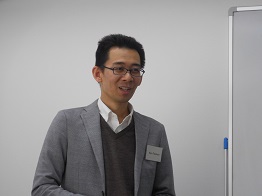
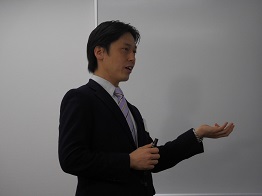
(Left) Daniel Aldrich, Northeastern Univ. "How social capital matters during and after disasters"; (Right) Q&A session
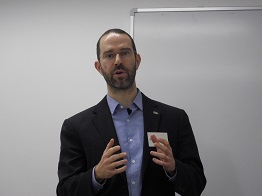
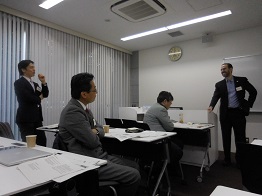
Session 2; 12:50-17:15 Chair, Daniel P. Aldrich
(Left) Jamie Lien, Chinese Univ. of Hong Kong, "Major earthquake experiences and presently-focused expenditures"; (Right) Yuki Higuchi, Nagoya City Univ. "Disaster aid targeting and political connection: Evidence from the Philippines"
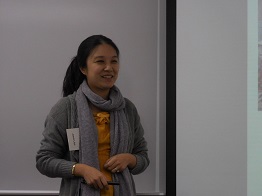
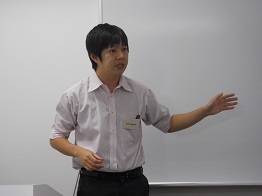
(Left) Yasuyuki Sawada, Tokyo Univ. "Disaster and preference: A united thery and evidence from the Philippines and Japan"; (Right) Masaharu Tsubokura, Tokyo Univ. "Medical assistance for the 23km zone after the Fukushima Dai-ichi nuclear disaster"
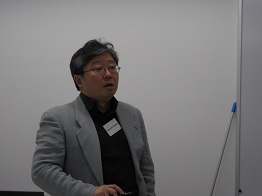
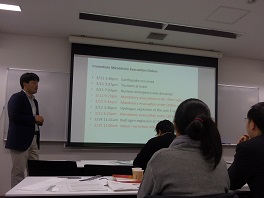
(Left) Minhaj Mahmud, BRAC Univ., "Natural disaster and risk sharing behavior: Experimental evidence from Bangladesh”; (Right) Yasuyuki Sawada, Tokyo Univ., Closing Remarks
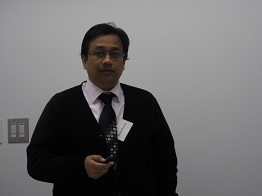
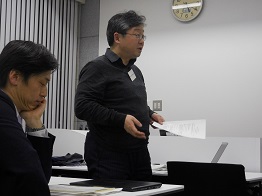
---------------------------------------------------------------------------------------------
Date/Time: December 19, 2016, 9:30am-17:15pm
Place: University of Tokyo, Kojima Hall, Seminar Room No. 1
Organizers:
Yasuyuki Sawada, Univ. of Tokyo and Daniel P. Aldrich, Northeastern Univ.
Program:
9:30-9:40 Conference Welcome from Prof. Yasuyuki Sawada
Session 1: 9:40-12:10 Chair, Yasuyuki Sawada
(Left) Toru Tsuboya, Tohoku Univ. "Types of disaster damage and change in depressive symptoms among survivors in Iwanuma, Miyagi"; (Right) Naoki Kondo, Tokyo Univ. "Disasters, economic crisis and social capital: evidence from social epidemiology"


(Left) Daniel Aldrich, Northeastern Univ. "How social capital matters during and after disasters"; (Right) Q&A session


Session 2; 12:50-17:15 Chair, Daniel P. Aldrich
(Left) Jamie Lien, Chinese Univ. of Hong Kong, "Major earthquake experiences and presently-focused expenditures"; (Right) Yuki Higuchi, Nagoya City Univ. "Disaster aid targeting and political connection: Evidence from the Philippines"


(Left) Yasuyuki Sawada, Tokyo Univ. "Disaster and preference: A united thery and evidence from the Philippines and Japan"; (Right) Masaharu Tsubokura, Tokyo Univ. "Medical assistance for the 23km zone after the Fukushima Dai-ichi nuclear disaster"


(Left) Minhaj Mahmud, BRAC Univ., "Natural disaster and risk sharing behavior: Experimental evidence from Bangladesh”; (Right) Yasuyuki Sawada, Tokyo Univ., Closing Remarks


---------------------------------------------------------------------------------------------
Stanford Event: Nuclear Safety And Security In Northeast Asia: A Panel Discussion [Report]
Nuclear Safety And Security In Northeast Asia: A Panel Discussion (October 19, 2016)
Sponsored by: Shorenstein Asia-Pacific Research Center
Date/Time: October 19(W), 12:00-1:30pm
Venue: Bechtel Conference Center, Encina Hall, Stanford
Moderator:
Takeo Hoshi, Henri H. and Tomoye Takahashi Senior Fellow in Japanese Studies, Freeman Spogli Institute for International Studies
Panelists:
Liyou Zha, Deputy Consul General of the People Public of China, San Francisco
Shouichi Nagayoshi, Deputy Consul General of Japan, San Francisco
Jimin Kim, Deputy Consul General of the Republic of Korea, San Francisco
Phillip Lipscy, TheThomas Rohlen Center Fellow, Freeman Spogli Institute for International Studies, Associate Professor of Political Science
Photo:
Prof. T. Hoshi, Mr. L. Zha, Mr. S. Nagayoshi, Mr. J. Kim and Prof. P. Lipscy
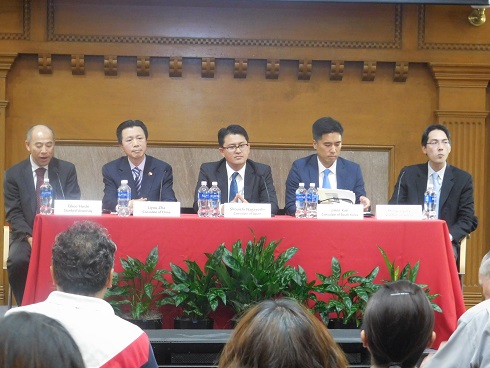
Webpage: https://events.stanford.edu/events/628/62811/
"Northeast Asia is now a central arena to determine the future of nuclear safety and security. The Fukushima nuclear accident, and its ongoing aftermath, is at the forefront of the debate over the utility of nuclear energy in resolving global issues of climate change and energy security. And North Korea’s headlong rush towards acquisition of nuclear weapons and delivery systems has sparked talk of going nuclear in both South Korea and China and discussion over how to provide extended deterrence, including the role of missile defense."
Review:
When diplomats stationing in a local city like San Francisco talk about national and international issues such as nuclear safety and security, all you can expect is what may be called "diplomatic talks." It was no exception this time, as the three diplomats claimed that their governments were doing their best in achieving "nuclear safety and security" by cooperating among the three countries, even in dealing with the "trust deficit" issue about nuclear safety and the "North Korea" issue about nuclear security.
Whenever they had to mention some unresolved problems, the key word "challenge" was used to avoid admission of inabilities or even failures in addressing such problems.
It turned out to be so obviously "diplomatic," when the three deputy consuls responded to the question from the floor, asking how their governments are dealing with the public's strong opposition to nuclear power, that is, the problem of seemingly increasing trust deficit: the Korean deputy consul said something like "educating people," and the Japanese deputy consul emphasized "dialogue with the public," while the Chinese deputy consul somewhat surprisingly that "the government listens and can change its mind in building nuclear plants," although that could happen only in some neighborhoods, but certainly not for the nation as a whole, as the Chinese diplomat himself initially presented that there were 27 nuclear power plants currently in operation, and 25 more under construction, which looks like a very aggressive pro-nuclear power policy.
Prof. Lipscy raised an interesting point regarding the possible implications of changing political atmosphere and shifting public opinions in the US regarding nuclear proliferation in Asia, but unfortunately there was no response from any panelist or even from the floor. Probably, we need another round of panel discussion, preferably by specialists, on such an issue.
(T. Miyao)
References:
Stanford Colloquium:Japan's Great Earthquake & Nuclear Disaster: 5 Years Later" (March 10, 2016)
http://miyao-blog.blog.so-net.ne.jp/2016-03-11
--------------------------------------------------------------------------------------------
Sponsored by: Shorenstein Asia-Pacific Research Center
Date/Time: October 19(W), 12:00-1:30pm
Venue: Bechtel Conference Center, Encina Hall, Stanford
Moderator:
Takeo Hoshi, Henri H. and Tomoye Takahashi Senior Fellow in Japanese Studies, Freeman Spogli Institute for International Studies
Panelists:
Liyou Zha, Deputy Consul General of the People Public of China, San Francisco
Shouichi Nagayoshi, Deputy Consul General of Japan, San Francisco
Jimin Kim, Deputy Consul General of the Republic of Korea, San Francisco
Phillip Lipscy, TheThomas Rohlen Center Fellow, Freeman Spogli Institute for International Studies, Associate Professor of Political Science
Photo:
Prof. T. Hoshi, Mr. L. Zha, Mr. S. Nagayoshi, Mr. J. Kim and Prof. P. Lipscy

Webpage: https://events.stanford.edu/events/628/62811/
"Northeast Asia is now a central arena to determine the future of nuclear safety and security. The Fukushima nuclear accident, and its ongoing aftermath, is at the forefront of the debate over the utility of nuclear energy in resolving global issues of climate change and energy security. And North Korea’s headlong rush towards acquisition of nuclear weapons and delivery systems has sparked talk of going nuclear in both South Korea and China and discussion over how to provide extended deterrence, including the role of missile defense."
Review:
When diplomats stationing in a local city like San Francisco talk about national and international issues such as nuclear safety and security, all you can expect is what may be called "diplomatic talks." It was no exception this time, as the three diplomats claimed that their governments were doing their best in achieving "nuclear safety and security" by cooperating among the three countries, even in dealing with the "trust deficit" issue about nuclear safety and the "North Korea" issue about nuclear security.
Whenever they had to mention some unresolved problems, the key word "challenge" was used to avoid admission of inabilities or even failures in addressing such problems.
It turned out to be so obviously "diplomatic," when the three deputy consuls responded to the question from the floor, asking how their governments are dealing with the public's strong opposition to nuclear power, that is, the problem of seemingly increasing trust deficit: the Korean deputy consul said something like "educating people," and the Japanese deputy consul emphasized "dialogue with the public," while the Chinese deputy consul somewhat surprisingly that "the government listens and can change its mind in building nuclear plants," although that could happen only in some neighborhoods, but certainly not for the nation as a whole, as the Chinese diplomat himself initially presented that there were 27 nuclear power plants currently in operation, and 25 more under construction, which looks like a very aggressive pro-nuclear power policy.
Prof. Lipscy raised an interesting point regarding the possible implications of changing political atmosphere and shifting public opinions in the US regarding nuclear proliferation in Asia, but unfortunately there was no response from any panelist or even from the floor. Probably, we need another round of panel discussion, preferably by specialists, on such an issue.
(T. Miyao)
References:
Stanford Colloquium:Japan's Great Earthquake & Nuclear Disaster: 5 Years Later" (March 10, 2016)
http://miyao-blog.blog.so-net.ne.jp/2016-03-11
--------------------------------------------------------------------------------------------



